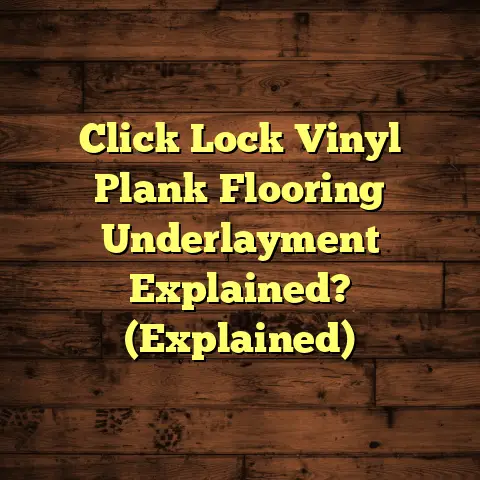Warped Floors: The Real Culprits? (1 Cause Exposed!)
(1 Cause Exposed!)
Ever walked into a slick, modern smart home and felt that something was just… off?It’s like they’ve got the latest gadgets, voice- controlled lighting, and a thermostat that knows your mood.
But what about the foundation underneath it all?
I’m talking about your floors.
As a flooring contractor for over 15 years, I’ve seen it all. And trust me, a warped floor can throw a wrench in even the smartest of homes.
We’re diving deep into why floors warp, and I’m going to reveal the one culprit that’s behind most of the problems.
Ready? Let’s get to it!
Section 1: Understanding
Warped Floors
Okay, so what exactly is a warped floor?
Simply put, it’s when your flooring isn’t flat and even anymore.
Think of it like a funhouse mirror – but for your feet.
You might notice:
-
Cupping: The edges of the boards are higher than the center.
-
Crowning: The opposite of cupping; the center is higher than the edges.
-
Buckling: The floor is literally lifting off the subfloor, creating tent-like shapes.
These issues can pop up in various types of flooring, including:
-
Hardwood: This is the most common victim, given its natural properties.
-
Laminate: While more resistant than hardwood, laminate can still warp if moisture gets in.
-
Vinyl: Even vinyl, which is known for its water resistance, isn’t immune to warping under extreme conditions.
Beyond the unsightly appearance, warped floors can be downright dangerous.
Trip hazards, unstable surfaces, and even decreased property value are all real concerns.
Nobody wants to show off their smart home with a floor that’s trying to play the limbo!
Section 2: The One Cause
Exposed—Moisture Issues
Alright, drumroll please…
The number one cause of warped floors, hands down, is moisture.
I know, it might seem obvious, but the way moisture wreaks havoc is more complex than you might think.
Wood, in particular, is hygroscopic.
That means it naturally absorbs and releases moisture from the air.
Think of it like a sponge.
When there’s too much moisture, the wood expands.
When it dries out, it shrinks.
1. Sources of Moisture
Where does all this moisture come from?
Let’s break it down:
-
High Humidity Levels: Ever notice how your floors feel a little different in the summer? That’s humidity at work.
Areas with consistently high humidity, like the Southeast US, are particularly susceptible. (Source: EPA Humidity information)
-
Water Leaks from Plumbing: A leaky pipe under the sink or behind the toilet can slowly saturate the subfloor, leading to warping.
I once had a client whose entire kitchen floor had to be replaced because of a tiny, undetected leak.
-
Flooding or Natural Disasters: This is an obvious one, but even a small amount of floodwater can cause significant damage to your floors.
-
Inadequate Ventilation: Poor ventilation in bathrooms and kitchens traps moisture, creating a breeding ground for warping.
-
Improper Installation of Flooring Materials: This is a big one!
If your flooring wasn’t installed correctly, it’s more vulnerable to moisture damage.
Things like not leaving enough expansion gaps around the edges of the room can cause buckling when the wood expands.
2. Impact of Climate
Where you live plays a huge role in your floor’s well- being.
For example:
-
Humid Regions: As I mentioned earlier, the Southeast US is a hot spot for humidity-related flooring problems.
The constant moisture in the air makes it difficult to keep floors dry.
-
Areas with Seasonal Changes: Places with harsh winters and humid summers experience significant swings in moisture levels.
This constant fluctuation can put a lot of stress on your floors.
-
Dry Climates: Believe it or not, too little moisture can also be a problem.
In extremely dry climates, wood can dry out and crack, leading to gaps and uneven surfaces.
3. Building Design and
Maintenance
Your home’s design and how you maintain it can either help or hurt your floors.
-
Poor Drainage: If water doesn’t drain away from your foundation properly, it can seep into your basement or crawl space, creating a moisture nightmare.
-
Lack of Ventilation: As mentioned before, proper ventilation is crucial for removing excess moisture.
-
Neglecting Maintenance: Regularly inspecting your plumbing, sealing grout lines, and cleaning up spills promptly can go a long way in preventing moisture damage.
Section 3: The Homeowner’s
Perspective
I’ve seen the devastation of warped floors firsthand.
Let me share a couple of stories:
Sarah’s Story: Sarah, a young professional, bought her dream condo in the city.
She loved the hardwood floors, but within a year, she noticed cupping in the living room.
Turns out, a slow leak in the neighbor’s bathroom above was the culprit.
The emotional toll was huge – her dream home was turning into a source of stress.
Mark’s Experience: Mark, a retiree, had laminate flooring installed in his basement.
He thought it was waterproof, but after a heavy rainstorm, he discovered buckling throughout the entire basement.
The financial hit was significant, not to mention the inconvenience of having to replace all the flooring.
These stories highlight the importance of understanding the risks and taking proactive measures.
Warped floors aren’t just an aesthetic issue; they can impact your life in real, tangible ways.
Section 4: The Role of Smart
Home Technology in Monitoring Moisture Levels
Okay, here’s where your smart home can actually help prevent warped floors!
Technology offers some cool solutions for monitoring moisture levels and catching problems early.
Here are a few devices to consider:
-
Smart Humidity Sensors: These little gadgets measure the humidity levels in your home and send alerts to your phone if they go outside the ideal range.
Brands like SensorPush and Aqara are popular choices.
-
Leak Detection Systems: These systems use sensors to detect leaks in your plumbing and alert you immediately.
Some systems, like Flo by Moen, can even automatically shut off your water supply to prevent further damage.
-
Smart Thermostats that Adjust Humidity: Some smart thermostats, like Ecobee, can automatically adjust the humidity levels in your home to prevent moisture buildup.
These technologies empower you to take control of your home’s environment and prevent moisture problems before they escalate.
It’s like having a 24/7 moisture patrol!
Section 5: Long-term Solutions
to Prevent Warped Floors
Alright, let’s talk about prevention.
Here are some long-term solutions to keep your floors happy and warp-free:
-
Proper Installation Techniques: This is crucial!
Make sure your flooring is installed by a professional who understands the importance of moisture barriers, expansion gaps, and proper subfloor preparation.
-
Regular Maintenance and Inspections: Regularly inspect your plumbing for leaks, seal grout lines, and clean up spills promptly.
-
Home Design Considerations: Ensure your home has proper drainage and ventilation.
Consider installing a vapor barrier in your crawl space or basement.
-
Moisture Barriers: These barriers prevent moisture from seeping up from the subfloor into your flooring.
-
Choosing the Right Materials: In areas prone to moisture, consider using water-resistant flooring options like tile or vinyl.
These proactive measures can significantly reduce your risk of warped floors and protect your investment.
Section 6: Conclusion: The
Importance of Awareness
So, there you have it.
The real culprit behind warped floors is almost always moisture.
Understanding the sources of moisture, the impact of climate, and the importance of proper installation and maintenance is key to protecting your floors.
And with the help of smart home technology, you can take control of your home’s environment and prevent moisture problems before they start.
Closing Thoughts
Take a walk around your home today.
Look for signs of moisture – water stains, musty odors, or uneven floors.
Consider investing in smart home technology to monitor moisture levels.
Remember, your floors are the foundation of your home.
By taking care of them, you’re protecting your investment and ensuring a healthy, comfortable living environment for years to come.
Don’t let warped floors ruin your smart home experience.
Be vigilant, be proactive, and keep those floors flat!
Good luck!





